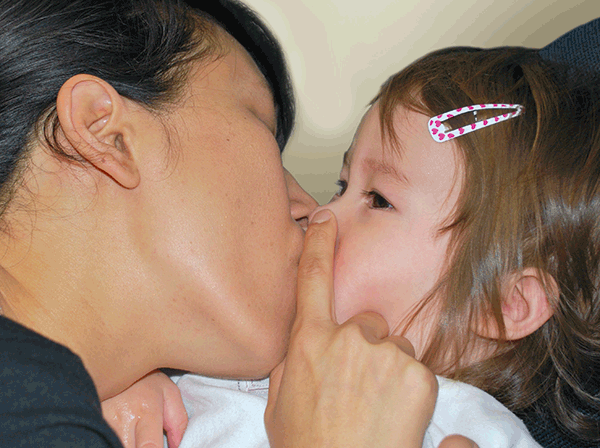The condition
Nasal foreign bodies
Children aged 2–5 years have the highest incidence of nasal foreign bodies, with some studies suggesting a greater incidence in males.
It presents most commonly with a history of a foreign body being inserted into the nose and no symptoms. Less common presentations include unilateral nasal discharge, odour or epistaxis. In the majority of cases the parent will present concerned about a foreign body in their child’s nose.
Foreign bodies may be inorganic items (eg. beads, stones or crayons) or food items. If the foreign body is a disc-type battery, the child should be taken immediately to the nearest hospital emergency department, due to the risk of tissue necrosis.
The intervention
How to perform the ‘mother’s kiss’
The procedure should be fully explained to the mother (or other trusted adult) and the child told they will be given a ‘big kiss’. In order to expel the foreign body, the mother (or other trusted adult) then:
- places their mouth over the child’s open mouth, forming a firm seal as if performing mouth-to-mouth resuscitation (Figure 1)
- occludes the unaffected nostril with a finger (Figure 1)
- blows until they feel resistance caused by the closure of the child’s glottis
- gives a sharp exhalation to deliver a short puff of air into the child’s mouth (which passes through the nasopharynx and out through the unoccluded nostril).
If necessary, the procedure can be repeated a number of times.

Figure 1. The mother’s kiss technique
How effective is it?
The mother’s kiss technique is effective approximately 60% of the time, irrespective of the type of foreign body.
Even when not successful, the mother’s kiss technique may improve the visibility of the foreign body, making removal by another technique easier.
What should I consider?
Considerations
It is recommended that the mother (or other trusted adult) perform the procedure under medical supervision:
- a number of theoretical risks have been proposed, such as barotrauma to the tympanic membranes and lower airways. However, there has never been a reported incidence of tympanic membrane rupture or pneumothorax using the mother’s kiss technique
- the main danger in removing a nasal foreign body by any technique is aspiration, particularly in a child who is uncooperative.
Adverse effects
No adverse effects have been reported.
Evidence
National Health and Medical Research Council (NHMRC) Level 1 evidence (systematic review of randomised controlled trials).
Resources
Key references
- Cook SC, Burton DM, Glasziou P. Efficacy and safety of the ‘mother’s kiss’ technique: a systematic review of the case reports and case series. CMAJ 2012;184:E904–12
- Fischer JI, Tarabar A. Nasal foreign bodies. Available at http://emedicine.medscape.com/article/763767-overview#a1
- Purohit N, Ray S, Wilson T, Chawla OP. The ‘parent’s kiss’: an effective way to remove paediatric nasal foreign bodies. Ann R Coll Surg Engl 2008;90:420–2.
Patient resources
The emedicinehealth website provides a comprehensive view of nasal foreign bodies. Available at www.emedicinehealth.com/foreign_body_nose/article_em.htm and a description of the mother’s kiss technique (note the technique is not named in the article) is given in the ‘Foreign body in the nose self-care at home section’.
Acknowledgements
Members of the HANDI Project Team include Professor Paul Glasziou, Dr John Bennett,
Dr Peter Greenberg, Professor Sally Green, Professor Jane Gunn, Associate Professor Tammy Hoffman and Associate Professor Marie Pirotta.
Competing interests: None.
Provenance and peer review: Commissioned; not peer reviewed.